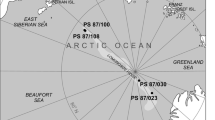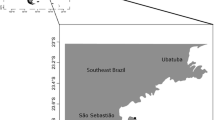Abstract
A second tube-dwelling anemone species of the genus Botruanthus (Cnidaria: Ceriantharia), B. mexicanus sp. nov., was observed in the Veracruz Reef System (1 m depth), Veracruz, Gulf of Mexico, and is described herein. To date, the recorded range of Botruanthus has been restricted to the Pacific Ocean. This new species is the first of this genus reported from the Atlantic Ocean. The number of tentacles, the number of mesenteries attached to the siphonoglyph, and the size of P2 mesentery permit a decisive distinction from Botruanthus benedeni. Some comments are provided, nonetheless, on the difference between Botrucnidifer and Botruanthus, the only two genera of the family Botrucnidiferidae.




Similar content being viewed by others
References
Arai MN (1965) A new species of Pachycerianthus, with a discussion of the genus and an appended glossary. Pac Sci 19:205–218
Carlgren O (1912) Ceriantharia. Danish Ingolf-Exped 5(3):1–78
Carlgren O (1951) The actiniarian fauna of the Gulf of California. Proc US Natl Mus 101:415–449
den Hartog JC (1977) Descriptions of two new Ceriantharia from Caribbean Region, Pachycerianthus curacaoensis n. sp. and Arachnanthus nocturnus n. sp., with a discussion of the cnidome and of the classification of the Ceriantharia. Zool Med Leiden 51:211–248
England KW (1991) Nematocysts of sea anemones (Actiniaria, Ceriantharia and Corallimorpharia: Cnidaria): nomenclature. Hydrobiologia 216(217):691–697. doi:10.1007/BF00026532
Estrada-Flores E, Peralta L, Rivas P (1982) Manual de Técnicas Histológicas. AGT, México, p 146
Fautin DG, Hickman CP, Daly M, Molodtsova T (2007) Shallow-water sea anemones (Cnidaria: Anthozoa: Actiniaria) and tube anemones (Cnidaria: Anthozoa: Ceriantharia) of the Galápagos Islands. Pac Sci 61:549–573
McMurrich JP (1910) Actiniaria of the Siboga expedition. Part I. Ceriantharia Siboga-Exp Monogr 10:1–48
Molodtsova TN (2001) Cerianthids (Anthozoa, Cnidaria) from Bengual upwelling region. 3. Botrucnidifer shtockmani. Zool Zhurnal 80:1027–1037 (in Russian)
Molodtsova TN (2004) Ceriantharia (Cnidaria: Anthozoa) from the Faroe Island. Fróðskaparrit 51:292–297
Stampar SN, Maronna MM, Vermeij MJ, Silveira FL, Morandini AC (2012) Evolutionary diversification of banded tube-dwelling anemones (Cnidaria; Ceriantharia; Isarachnanthus) in the Atlantic Ocean. PLoS One 7(7), e41091. doi:10.1371/journal.pone.0041091
Stampar SN, Maronna MM, Kitahara MV, Reimer JD, Morandini AC (2014a) Fast-evolving mitochondrial DNA in ceriantharia: a reflection of hexacorallia paraphyly? PLoS One 9, e86612. doi:10.1371/journal.pone.0086612
Stampar SN, Morandini AC, Silveira FL (2014b) A new species of Pachycerianthus (Cnidaria, Anthozoa, Ceriantharia) from tropical Southwestern Atlantic. Zootaxa 3827:343–354. doi:10.11646/zootaxa.3827.3.4
Stampar SN, Morandini AC, Branco LC, Silveira FL, Migotto AE (2015a) Drifting in the oceans: Isarachnanthus nocturnus (Cnidaria, Ceriantharia, Arachnactidae), an anthozoan with an extended planktonic stage. Mar Biol 162:2161–2169. doi:10.1007/s00227-015-2747-0
Stampar SN, Beneti JS, Acuña FH, Morandini AC (2015b) Ultrastructure and tube formation in Ceriantharia (Cnidaria, Anthozoa). Zool Anz 254:67–71. doi:10.1016/j.jcz.2014.11.004
Stampar SN, Maronna MM, Kitahara MV, Reimer JD, Beneti JS, Morandini AC (2016) Ceriantharia in current systematics: life cycles, morphology and genetics. In: Goffredo S, Dubinsky Z (eds) The Cnidaria, past, present and future: the world of Medusa and her sisters. Springer. doi:10.1007/978-3-319-31305-4
Torrey HB, Kleeberger FL (1909) Contributions from the laboratory of the marine biological association of San Diego. XXVII. Three species of Cerianthus from southern California. Univ Calif Publ Zool 6:115–125
Tunnel JW (2007) Reef distribution. In: Tunnell JW, Chávez EA, Withers K (eds) Coral reefs of the Southern Gulf of Mexico. Texas A&M University Press, Harte Research Institute, Texas, pp 14–22
van Beneden E (1897) Les Anthozoaires de la ‘Plankton-Expedition. Ergebnisse der Plankton-Expedition der Humbolt-Stiftung 2:1–222
Acknowledgments
This work was supported in part by São Paulo Research Foundation (FAPESP 2015/24408-4 to SNS, and 2010/50174-7, 2011/50242-5 to ACM), CNPq 481549/2102-9 to SNS, 301039/2013-5 and 476339/2013-8 to ACM, and by a grant (209690/202677) from the Consejo Nacional de Ciencia y Tecnología (CONACYT) to RGM for studies in the postgraduate program in the PCMyL-UNAM. This is a contribution of the NP-BioMar, USP. We would like to thank Drs. Torkild Bakken (Norwegian University of Science and Technology, Museum of Natural History and Archaeology), Stephen D. Cairns and Allen G. Collins (Smithsonian Institution, National Museum of Natural History), and Jonathan Lawley (Universidade de São Paulo) for providing access to specimens; Biól. José Luis Tello-Musi, M.S. Alfredo Gallardo-Torres, Dr. Nuno Simões (UNAM), and Dr. Horacio Pérez-España (Instituto de Ciencias Marinas y Pesquerías de la Universidad Veracruzana), who provided support for field work; Dr. Leopoldina Aguirre-Macedo (Centro de Investigación y Estudios Avanzados del Instituto Politécnico Nacional) and M.S. Maribel Badillo-Alemán (UNAM), who provided support and access to histological facilities; and M.S. Gemma Martínez-Moreno and Dr. Patricia Guadarrama-Chávez (UNAM), who helped with lab work and provided support in the microscopy lab.
Author information
Authors and Affiliations
Corresponding author
Additional information
Communicated by B. W. Hoeksema
This article is registered in ZooBank under urn:lsid:zoobank.org:pub:5E11B034-5B84-4DD8-88A5-08A2550FD22C
Rights and permissions
About this article
Cite this article
Stampar, S.N., González-Muñoz, R. & Morandini, A.C. Botruanthus mexicanus (Cnidaria: Ceriantharia), a new species of tube-dwelling anemone from the Gulf of Mexico. Mar Biodiv 47, 113–118 (2017). https://doi.org/10.1007/s12526-016-0521-2
Received:
Revised:
Accepted:
Published:
Issue Date:
DOI: https://doi.org/10.1007/s12526-016-0521-2




